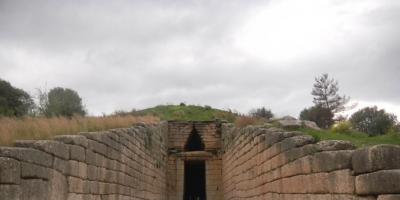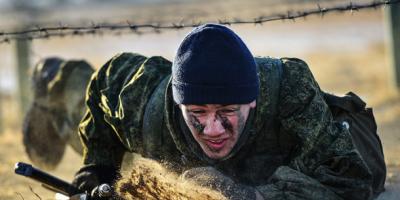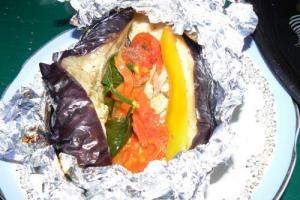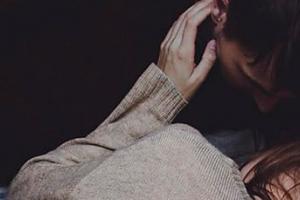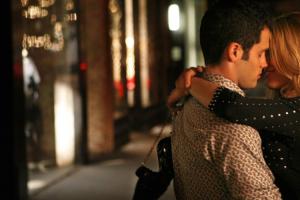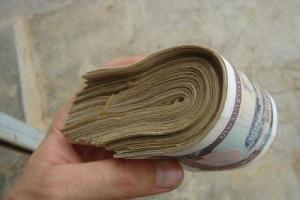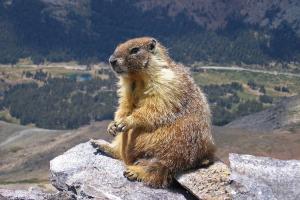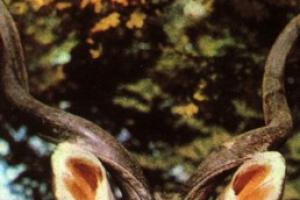After taking a short break in Israel and dreaming about the Big Three, we return to Morocco, to the real city of dreams. In fact, as strange as it may seem to say now, this whole trip was started because of Chefchaouen. That is, of course, there was also the Sahara and the Kasbah of Ait Bin Haddou, Tangier and the Atlas Mountains, but it was the blue city, from the moment I first saw it in photographs, that attracted me to this beautiful and mysterious country.
We stopped with you at the very entrance to Chefchaouen

Already at the entrance you can see all shades of white and blue

Although from here it is not yet so noticeable that the dominant color of Chefchaouen is blue

We stop at the foot of the Medina gate

No, this is not the entrance yet Old city, although there is enough here beautiful houses and mosques

Historic Bab El Ain Gate - built during the reign of Moulay Ali Ben Musa Rashid el-Alami (1471-1511), the founder of the city. More about him below.

And immediately everything starts to turn blue


Like doors


So are the streets


One can argue for a long time, probably, whether Chefchaouen is more beautiful than Tangier -


Or than the blue and white Kasbah of Udaya in Rabat -


But in my opinion Chefchaouen is the most beautiful of all

This is something incredible

Some corners just really take your breath away

Or from houses. My jaw actually dropped at this point.

If anyone hasn’t read my previous posts, Chefchaouen is located in the Rif Mountains, not far from Tangier - and Tetouan

The city was founded in 1471. Moulay Ali Ben Musa Rashid el-Alami (descendant of Idris I, and through him - then the Prophet Muhammad) built a small fortress here in order to repel the attacks of the Portuguese. The Kasbah, by the way, has survived to this day.

Within twenty years the city began to develop rapidly, since it was here that people fled to large quantities Jews and Moriscos (Muslims of Andalusia) after the completion of the reconquista - the capture of Spain by Christians.

In 1492, they captured Granada and literally three months later issued the Edict of Alhambra, ordering all non-believers to leave the country.

This is where the tradition of painting houses blue begins.

And it came, like everything else in the world, from the Jews)

Jews believe blue is the color of heaven


And he reminded them of God


And also - about the promised land, to which they will someday return (I don’t know, however, whether they dreamed of Israel and the lost Jerusalem, or Spain and the lost Granada, Seville and Cordoba)

Andalusian influence is also felt in Chefchaouen

The porches are lined with multi-colored tiles


And sometimes doors too


In 1948, when the State of Israel was created, the majority of Jews left Chefchaouen.


And the tradition is to paint houses in Blue colour preserved.

By the way, I have a question about this - if the Jews knew how to paint cities in the Diaspora so beautifully

Why don't they do this in Israel itself?


The climate seems to be similar, there is no shortage of paint.



Why do all cities (in the color sense of the word) look like my life?

I'm not even talking about the city where I live, Bnei Brak, whose gray square boxes make me want to hang myself every day.


So it’s no surprise that I’m so delighted with Chefchaouen

The city took an honorable second place on the list of my favorite moments in Morocco -

And it will clearly be included in the list of my ten favorite cities in general - in its next update.


It is interesting to compare Schauen with small European towns. Let's say Torun - , Akureyri - or Castle Combe - . The comparison is difficult because the style is so different, but the Moroccan city is clearly on par with its European counterparts.

Fountain of Bab El Souk. Built in the forties of the 20th century, it is famous for its special ornamentation. There are many such fountains in the Chefchaouen Medina; I will tell you about the rest in the second part.

Returning to the history of the city - it got its name from the Berber word Ishaouen, meaning “horns” (the two mountain peaks surrounding the city look like horns).

In 1920, the Spaniards captured the city (remember, a few years earlier the uprising of local tribes against European colonialism began) and made Chefchaouen part of Moroccan Spain. However, unlike Ceuta and Melilla, they gave the city away after Morocco gained independence in 1956.

The mezquita (mosque) of Bab El Souk is located near the fountain. Built with money raised by residents of the Souk quarter.


Wikipedia, by the way, reports that Chefchaouen was repainted blue by Jews, but those who fled here from Hitler in the thirties. Another proof that you shouldn’t believe everything written on Wikipedia. But at least they weren’t mistaken about the Jews, and thank you for that

Well, for now we'll go through the market


To the main square

It's called Uta Hammam

And here, as is usually the case, the main attractions are located. The already mentioned Kasbah (more about it in the next post)

Great Mosque. Built by Prince Mohammed Ben Ali Ben Rashid during his reign (1540-1560)

Andalusian courtyards

And the market, of course. If you suddenly need to buy a leather handbag.

Another thing that is very easy to buy in Chefchaouen is kief (marijuana, hashish, etc.). The whole city simply smelled of this wonderful smell, and it becomes clear why hippies from all over the world flocked here before)

We will stop on this pleasant note. To be continued)
An article for those who are interested in what to see in Morocco and where to stay overnight.
Our journey went from south to north of Morocco. Of the ten days spent in the country, we visited eight cities and villages, where some of the most interesting sights are located. I’m talking about cities and nuances based on ours. I also want to dwell on those hotels (riads and kasbahs) that we liked for the level of service, atmosphere and convenient location.
Morocco has a special type of hotels - if you plan to live in cities, choose private riads instead of chain hotels; if in the desert or oases, hotels are often located in so-called kasbahs. A riad is a traditional house or palace that is built in the shape of a well, inside which there is a garden and a fountain, often even a swimming pool. Typically, riads are located in the Old Medina, the historical center of the Moroccan city.
Riads usually have several floors, accessed by narrow staircases (hello big suitcases!!!). On each floor there is a balcony overlooking the courtyard; rooms are located along the perimeter of the balcony. Riads come with private rooms with their own shower. There are riads - hostels, with rooms - dorms with shared amenities. If you are traveling as a couple, then there is no point in saving on a separate room - the cost of living in a good riad is low, a double room starts from 25 Euros per night with breakfast.

Kasbah is a traditional house with a large area, which is built from clay in the desert and mountains. High fence walls protect from dust and sand; behind them there is usually a wonderful garden, often a swimming pool. Thick walls keep the house cool in summer and warm in winter.

Book accommodation with breakfast– in Morocco they are tasty and rich: tea (coffee is tasteless, but you won’t find anything tasty here - the country is dedicated to tea), flatbreads and buns, scrambled eggs, yoghurt, vegetables, fruits, jams and traditional orange juice. If you wish, you can arrange for dinner - it makes sense to do this in the desert or in places where there are no restaurants nearby. In cities, it is better to go to cafes and restaurants and study Moroccan cuisine - without this you will not be imbued with the culture and tastes of Morocco.

Legzira and Sidi Ifni
We flew into Agadir to pick up a car from a rental office and head to a small town Sidi Ifni, which is 9 km from the famous arch on the ocean shore on the beach Legzira. Fantastic a nice place, despite the fact that a couple of years ago one of the arches collapsed under the pressure of the forces of nature. The second one remains in place and can still be seen.

Sidi Ifni– a hangout place for surfers, hippies and elderly couples from Europe. The territory in which Sidi Ifni is located is a former Spanish colony, so the locals here speak Spanish and there are quite a lot of Spaniards in the hotels.

We checked into a picturesque hotel - Suerte-Loca, which opened in Sidi Ifni in 1936. If we consider it from the comfort side, someone will say “horror, horror” for the hard pillows, mattresses and tired linen. I fell in love with this place with history - from the top balcony of the hotel there is a magnificent view of the beach, on the ground floor the owners run an amazing restaurant, where they cook and serve guests and guests. In the evenings, local musicians play fiery Spanish tunes; we didn’t want to leave dinner - the owners not only know how to cook, but also create an amazing atmosphere. And this is valuable!

Essaouira – fish and cats in blue doors
Essaouira- the largest fishing port, a fort city woven from narrow alleys, white walls and blue doors. In the 70s, hippies poured into Essaouira and turned it from a bastion into a world of relaxed, high life against the backdrop of ocean sunsets.

People come here for the atmosphere: sit on the roof of a riad, sipping mint tea, climb the walls of the bastion, wander along the huge curve of the beach at low tide, go to the fish market to look at the catch and blue boats, eat seafood, dance the night away in rock bars. The name Essaouira is translated from Arabic as " beautiful view", and it is truly beautiful in its colonial desolation.

For those who come to Essaouira by car, you can leave your car in the parking lot next to the entrance to the Medina. Price - 20 dihrams per day (2 Euro). Be prepared for the fact that after parking, the car will be covered in seagulls - this is taken advantage of by local helpers who, without asking permission, begin to wash the car with dirty rags and pour water from a bottle. Drive them away, their work is of no use, they demand money even if you drive them away - they say we are poor, and you are rich tourists. For reference, it’s worth washing your car inside and out at a normal car wash. 35 dihram(3.5 Euro). In short, don’t be fooled by helpers.

Marrakech – palaces, markets, delicious, noisy
Marrakesh - some people will like it right away, while others will want to leave it immediately. Marrakech has many museums, palaces, and tanneries similar to those in Fez. Since we don’t like to go to palace museums, and we only came for one night, we walked along the narrow streets, bought fruit, drank fresh juice for 10 dikhrams per large glass in the square Djemaa el Fna, there we ate local lamb kebabs, gazed at snake charmers from afar, walked to the Al-Kutubiya Mosque, fighting off charlatan fortunetellers and magicians.

In general, I didn’t understand this city and didn’t accept it, but for the future I still planned to have time to visit Garden Majorelle, which belonged to the French artist Jacques Majorelle, and then was bought by Yves Saint Laurent. We didn’t have time to go there, next time I’ll definitely go.

Ait Benhaddou and Ouarzazate – mountains and ancient fortresses
Fortress or ksar Aint Benhaddou is located behind the High Atlas. It takes at least 10 hours to get there from Marrakech, but the road through the mountains, although difficult, is worth it. Stunning views, gorges and peaks of the Atlas, which they teach about in geography lessons at school, are what make the path from point A to point B a self-sufficient interesting process.

Stop at viewpoints where fossils and colorful quartz crystals are often sold. Look around and do not rush to cross the mountains as quickly as possible - despite the fact that you will have to spend the whole day on the road, you will have amazing impressions of the change in alpine zones and landscapes. True, it will be quite difficult for those who get motion sickness on serpentines - stock up on vomit bags... For trekking lovers, there is an iconic peak in the High Atlas, trekking to the top Toubkal(4167 m) is my next destination for the trip to Morocco.

Ksar Ait Benhaddou is located beyond the pass among lifeless red mountains and valleys. Built from red clay, it still preserves the walls and towers of the fortified city, built in the 11th century in a valley located on the left bank of the Ouarzazate River. Hundreds of years ago, the caravan route from Timbuktu to Marrakech passed here. Nowadays, within the walls of the fortress there are sellers of carpets and shawls; for 20 dihrams you can see how the locals lived in small houses. Or take a look yourself into the slowly falling apart houses of Ait Benhaddou.

We stopped for the night on the outskirts Ouarzazate- a fairly large city by Moroccan standards, which is located 15 km from the fortress. We liked the hotel Chay- a small kasbah built by two young Moroccans who had recently graduated from university and had time to see the world and understand the tourism business. I warmly recommend this hotel, despite the fact that it is not in the city center - you can only get here by car or negotiate with the owners about a transfer.

The house and garden behind high walls are located on the outskirts of a palm oasis, a very quiet and atmospheric place. The guys are amazingly hospitable, speak excellent English, cook deliciously, answer all questions and even taught me how to wind a Tuareg turban - tagelmust. They prepared us an amazingly delicious dinner by candlelight, and the breakfast was beyond praise.

What to see in Ouarzazate: Hollywood branch in Morocco, Atlas film studio, on which the scenery for films filmed in this country has been preserved. Entertainment is not for everyone, but many people like it. You can also look into the local historical center - Kasbah Taourirt, which is divided into museum and housing (read free parts). Not far from Ouarzazate near the village of Kelaa Mgouna is located "Valley of Roses"– in April and early May there are continuous rose festivals, and of course you can see rose plantations in their fragrant splendor.

Merzouga - the largest dunes in Morocco
I wrote about the desert, this is a must visit place in Morocco. The main thing is to choose one of two Saharan ergs (an area covered with sand dunes), located in Morocco. First - erg Chebbi adjacent to the village of Merzouga, located near the Er Rissani oasis, the second - erg Shigaga, is located 50 km west of the city of M'Hamid El Ghizlane. Erg near Merzouga is smaller (22 x 5 km), but the dunes in it reach 150 meters in height, Erg Shigaga is larger (40 x 15 km), but the dunes are much lower - up to 60 meters in height. I chose Merzougu for the wow effect of the height of the dunes, although it is more popular among tourists.

In the desert you can ride camels and quad bikes, watch the sunrise and watch the sunset, and spend the night in a tent in the center of the desert. In general, entertainment for every taste and budget. The price and living conditions here are also different - you can stay in a local house in a double room with all amenities and breakfast for 10 euros or in a hotel with a swimming pool - from 60 euros per room. Spend the night in the desert in a tent - from 40 Euro per person, camel ride - from 30 euros.
Fez – the scents and colors of the tanners' quarter
From Merzouga to Fez the road winds through the oases and gorges of the Middle Atlas, through high mountain valleys strewn with thousands of sheep and the pine forests of the Ifrane National Park - a city that is not at all like Morocco, more like Italian cities in the foothills of the Alps.
The 450 km long journey takes almost the whole day, but it is an amazing road from which only the best memories remain: desert, palm trees, mountains, gorges, reservoirs, mountain pastures and meadows, green forests where Moroccan macaques live, tiled roofs and European streets of Ifrane.
All this is worth spending a day and renting a car, which will give you the opportunity to stop in any place you like. It won't be the same from the bus.

So, Fes- a city of labyrinthine streets, mosques and artisan workshops. If you choose a riad in the Old Medina, I recommend it Dar Lalamoune— inexpensive, delicious breakfasts, close to parking outside the walls of the Medina ( 20 dihrams per day).
What to see? Of course, walking around the entire Medina of Fes is an indescribable feeling, as if you are falling into the past, spinning along narrow alleys where GPS does not even pick up.

The main attraction in Fez is Chouara Tannery Quarter. No matter how we tried to look at the production and painting of leather for free, we were never able to get through the extortions of local help. To see the tanning industry and the paint vats in all their glory, you need to go to one of the shops, from the top floor of which you can see the colorful vats of paint. Even as you approach, they will pester you - don’t be fooled, you’ll have to pay, but only at the entrance to the store, if you don’t plan to buy anything, but just came to look (from 15 dihrams per person).
 You will be handed a sprig of mint and head upstairs to the aromas and bright vats of paint. Mint fights off odors that are inevitable - when tanning leather, animal urea is used. To be honest, it’s tolerable even without mint, but the aroma is not for sissies.
You will be handed a sprig of mint and head upstairs to the aromas and bright vats of paint. Mint fights off odors that are inevitable - when tanning leather, animal urea is used. To be honest, it’s tolerable even without mint, but the aroma is not for sissies.
 Also, for a fee, you can visit inside the dyehouse, although the doors to the tannery workshop are wide open... As for the prices in the shops overlooking the dyehouses: it depends on what you compare with. I bought Moroccan bags and backpacks in Spain. Everything in Fez cost twice as much as in Santiago de Compostella. Prices are inflated, although many things here are much more expensive, and all because crowds of tourists come here.
Also, for a fee, you can visit inside the dyehouse, although the doors to the tannery workshop are wide open... As for the prices in the shops overlooking the dyehouses: it depends on what you compare with. I bought Moroccan bags and backpacks in Spain. Everything in Fez cost twice as much as in Santiago de Compostella. Prices are inflated, although many things here are much more expensive, and all because crowds of tourists come here.
Chefchaouen – a blue city among green mountains
Perhaps, Chefchaouen- this is my favorite place in Morocco, where I want to return again. The attitude towards visitors here is much calmer and friendlier than in Marrakesh and Fez. Despite the fact that the town has become completely touristic, there is a kind of quiet atmosphere reigning here.
We spent two days in Chaven and didn’t want to leave, despite the fact that I walked around all the streets and stairs there, looked into every open crack. In Chaven you need to walk and take photographs, sit in a cafe and listen to the cries of the muezzins, drink orange juice and wander among the souvenir shops - prices here are lower, the sellers are unobtrusive and willing to give discounts.

I recommend visiting the café at the waterfall if you go to Chef in the warm season - May-June or September. On the outskirts of the Medina there is a bridge with a river flowing under it. Under this bridge in hot weather, local sellers place plastic chairs and tables directly into the water. They sell it here Orange fresh at the same price as everywhere else - 10 dihrams. But the pleasure is 100 times greater when you sit with bare feet in cold water under the scorching Moroccan sun.

At sunset, everyone goes to the view point, located on the opposite hill near the Bouzâafar mosque. And when it gets dark, people gather in the square near the ethnographic museum - listen to street musicians, drink beer in the aromas of marijuana under the stars above the blue Chefchaouen.


The heavenly tones of the streets in the Moroccan city of Chefchaouen seem like a fairytale setting. Color palette The uphill medina is replete with piercing shades of blue, blue and azure. A city where the walls of buildings window frames, wooden doors of houses, steps and even flower pots filled with blue, is one of the largest tourist centers in northern Morocco. Rich shades of blue azure, turning into blue and violet tones, are renewed several times a year. Residents of Chaven paint their buildings anew before major holidays and festivals that take place in the city several times a year.
Chaven, founded in 1471 as a fortress to protect against Portuguese invaders, owes this color monotony to the local Jewish community. The city became one of the largest refuges for Jews expelled from Spain during the Reconquista. According to biblical covenants, blue and light blue shades of houses should symbolize the tallit (tales) prayer shawl and remind of God. The Jewish population of Chaven has declined significantly since the 15th century, but local residents have maintained the tradition of painting buildings in heavenly colors.
You can stay in Chaven for several days. In addition to walking around the medina and visiting the city museum, it is worth taking time to travel along the Er Rif (Ter Reef) mountain range that surrounds the city. The old part of the “blue city” is quite small - and you can walk along the narrow streets without a guide, but on an excursion to the mountains it is better to go with one of the local guides. A walk around the area traditionally begins north of the medina - from the famous Ras el Ma spring, which feeds fresh water the whole city.
In April and May, Chaven is especially picturesque. Flowers are blooming all over the city, the various shades of which contrast incredibly colorfully with the blue, azure and dark blue walls of the houses.
How to get there
The largest transport center closest to Chaven is the city of Tangier, located 85 kilometers to the northwest. You can also get to the “blue city” from Fez, Meknes, Casablanca, Rabat and other major tourist centers of Morocco.
Bus service is provided by the transport company CTM, whose flights connect Chaven with Fez and Meknes (travel time - four hours; ticket price - 70 MAD (~$7.0)), Casablanca (travel time - five and a half hours; bus departs daily at 13:15; ticket price - 120 MAD (~$12.0)), Rabat (travel time - four hours; bus leaves daily at 14:45; ticket price - 90 MAD (~$9.0)). You can get from Tangier with a transfer in Tetouan (total travel time is a couple of hours; ticket cost is about 45 MAD (~$4.5)).
There are no direct bus routes connecting Chaven with Agadir and Marrakech. The best way to get there is to change planes in Casablanca. Tickets can be purchased in advance at stations or on the CTM website. The Chaven bus station is located a short distance from the medina, at the bottom of the slope.
Location
Shawen lies at the foot of the Rif mountain range, in the northwest.
Having learned that I was going to Morocco, all my friends who had already been there advised me to definitely visit the blue city of Chaven. They said it was something. Spoiler – really, something.
A very beautiful place. No talking. And, yes, if it were the 19th century now, I would never have been able to get there. Intrigued? Then read on.
Perhaps it’s worth starting with the fact that only Russians call the blue city Chaven. The Moroccans themselves call it Chifchaun, and the Europeans call it Chefchaouen. Getting here from Tangier is easy.

Do not contact guides on the Internet who promise to take you to Chaven, give you a tour on the spot, and then take you back for 130 euros - we came across such offers when planning our trip.

It is better to go to the Tangier Grand Taxy Station in the morning and take a shared taxi. In fact, it’s just a car for six, the cost of travel to Chaven is 70 dirhams, which is equivalent to 7 euros. The only thing is you need to wait for fellow travelers to arrive.

The road to the blue city takes 2 hours. During the trip, you will see the mountains of Morocco, and women in traditional Berber outfits - they go about their business along the roadway, and donkeys and sheep grazing on the side of the road. They drop off tourists near the medina. Another 10 minutes on foot and you are already in the scenery, looking at which it is difficult not to start humming: “Blue, blue frost.”

Chaven is a small city, but other metropolises might envy its history. According to official data, the settlement was founded in 1471 by Emir Ali ben Moussa ben Rashid el Alami, who arrived in Morocco from neighboring Andalusia.

But, as they say, “this is not accurate.” According to other sources, Moroccan Berbers lived here long before the appearance of the emir. However, it was at the end of the 15th century that Chaven acquired a mosque, and at the same time a fortress, in order to defend against the Portuguese, who at that time were actively plowing the seas with far from peaceful goals and objectives.

The dawn of the city began in 1492, when Jews expelled from Spain arrived here en masse. Yes, in fact, for more than four centuries, Chaven was a Jewish city. Representatives of this people came here, of course, not because of a good life. Ferdinand II of Aragon and Isabella I of Castile, the most powerful and controversial royal couple in Spanish history, are to blame for everything.

On the one hand, during their reign, America was discovered by Columbus, Granada was captured, and Spain finally began to transform into an integral state, but Isabella and Ferdinand should also be “thanked” for the terrible Spanish Inquisition. The Jews had a hard time under the rule of the royal couple. At first they were moved to a ghetto, and in 1492 the rulers issued the Edict of Alhambra, according to which Jews were given only 4 months to either convert to Catholicism or leave the kingdom.

Actually, according to the most popular version, Jews expelled from Castile and Aragon came up with the idea of painting houses in Chaven blue and blue. They believed that in this way they would be closer to heaven. What is significant is that along with the chosen people, Muslim Moors also arrived in Morocco, because the rules of the already mentioned Edict of Alhambra also applied to them: Catholicism or exile.

The peoples lived together for some time, then mixed, and in fact the city became a Sephardic community - the place of residence of a subethnic group of Jews. Chaven remained this way until the beginning of the 20th century.

Moreover, at some point in history it was proclaimed a holy city, and people of other faiths were simply no longer allowed here. Only the French priest Charles Eugene de Foucault managed to outwit everyone: in 1883, he entered the city, pretending to be a rabbi.

Chaven became an open city only in 1912, after its conquest by Spanish troops. And a completely different chapter began in his story. The Spanish ruled Chavin until Moroccan independence in 1956, and it is said that the city was the last to lower the Spanish flag. However, the Spanish influence here is strong to this day: at least in Spanish Local residents speak much better than English.

A walk through Chavin is an endless wandering through nooks and alleys, descents, ascents and descents again. Observations of cats jumping from roof to roof. And taking pictures beautiful doors, of course, also painted in all shades of azure.

Yes, despite the fact that Muslims and not Jews now live in Chaven, the tradition of painting the facades of buildings blue not only did not disappear, but was also officially enshrined. Today, local residents are prohibited from coloring their homes to their own taste. It is believed that Marrakech should be terracotta, Asilah should be white, but Chaven should always be the color of heaven.

By the way, the city is famous for one more circumstance. Europeans come here to smoke kief, from the Arabic kayf, which means, of course, “pleasure.” Cannabis in Morocco is grown completely openly, and then delivered to Amsterdam. At the same time, drinking the potion pressed into cakes is not entirely legal here, but this stops few people.

The Spaniards even go to Schaven like they go to Amsterdam: to relax for the weekend, because it costs several times less. It is not surprising that in such a small city today there are as many as 200 hotels open, and they say that in the summer it is difficult to find a room here - there are so many people who want to taste the product from the plantations in the north of the country.

By the way, it seems that this alone may be the reason why many tourists hang out in the blue city for several days, or even a week. In fact, a couple of hours is more than enough to explore it. The third can be taken to lunch in one of the restaurants with a veranda: they are at every turn in Chaven, and the fourth can be spent haggling with local sellers of carpets and ceramics - especially skillful ones can reduce the price of the item they like by half.

Well, and then - again to the taxi stop, where there will definitely be 3-4 cars heading to Tangier. However, keep in mind that on the way back you can wait for your fellow travelers for a very long time. It took us 40 minutes to recruit people.
Did you like the material? Join us on facebook
Yulia Malkova- Yulia Malkova - founder of the website project. In the past, he was the editor-in-chief of the elle.ru Internet project and the editor-in-chief of the cosmo.ru website. I talk about travel for my own pleasure and the pleasure of my readers. If you are a representative of hotels or a tourism office, but we do not know each other, you can contact me by email: [email protected]
The city of Chefchaouen, Morocco, is located in the northwestern part of the country, in the Rif Mountains, between Tangier and Tétouan. There are several versions of the name of this city - Chaven, Chifchaun, Chefchaouen.
The name of the city of Chefchaouen comes from the shape of the peak of the Rif Mountain, which rises above the city. It resembles the horns of a goat. "Chef Chaouen" is translated as "look at the horns."
Getting to Chefchaouen is not so easy, but the flavor of this city is worth the long drive.
The city itself is one big attraction. It is famous primarily for its blue and blue color houses and streets.
The streets in the city are narrow and winding, the roofs of the houses are often red, made of tiles. The streets are very clean. But the way the houses are painted is simply amazing - the walls are blue, light blue, azure white.
It is with the blue and white colors of the streets that this city attracts the attention of numerous tourists who, despite the long journey, travel to Chefchaouen.
Riad
A traditional Moroccan home is called a riad. Usually, the outside of a riad looks gray, but in Chefchaouen there is a blue, plastered wall with a small wooden door. It seems that such a house looks dull and unpresentable. But the riad has a second, hidden from prying eyes, facade that opens onto the courtyard. This arrangement of the house perfectly protects privacy; from the street it is impossible to guess what is happening inside. The owners are reliably protected by the thick walls of the fortress house.
Usually such a house has two floors, but there are exceptions. All living quarters are located around the courtyard, as if surrounding it on all sides with a gallery of rooms. Some larger homes have trees and fountains on the patio. And in smaller houses, the courtyard serves as a “living room” for the whole family. The decoration inside a traditional riad is usually very beautiful. The courtyard is laid out mosaic tiles. The walls can be white, or they can be the brightest colors. And shutters and doors are often decorated with paintings.
Some riads have become small guest houses. Sometimes the owners live on the first floor and rent out the second floor to tourists.
Why is the city painted in these colors?
This tradition dates back to 1471. It was at this time that the Muslims, who defended their lands from the Portuguese invasion, built a fortress between the Reef Mountains. It had an extremely favorable location: it was protected by high mountain ranges, and the elevation on which the fortress was located made it possible to keep the surrounding lands under control.
When Jews from Spain came here in the 15th-17th centuries looking for salvation, they decided to find refuge in this place. It was from them that this tradition came - to paint buildings blue. The fact is that Jews perform their prayers using several attributes. One of them is a prayer shawl, which in turn has a tzitzit (a bundle of threads woven in a special way). And one of the main components of such a bundle is a blue thread. It must necessarily be a special color “tchelet”, described in the Talmud as “the color of the sea, similar to the color of the sky, similar to the color of the Throne of Glory of the Most High.” The Jews painted their houses blue and thus remembered that God was very close to them, and in this way they could get closer to him.
Today, on the streets of Chefchaouen you can find all shades: azure, like the surface of the sea, deep blue, reminiscent of infinity. However, thekhelet is originally a pale blue color, mostly close to white.
Sacred, closed city
For a long time, Chefchaouen was declared a holy city. This completely closed the entrance to the territory for non-believers. Those who wanted to disobey had to risk their own lives. Despite the fact that Chefchaouen is geographically close to Spain, Portugal, as well as the Mediterranean Sea and the Strait of Gibraltar, before the beginning of the 20th century, only three Europeans visited the blue city.
Each of them had to try a lot to avoid being detected by the local population. Thus, the French explorer Charles Eugene Foucault, in order to get into the city, disguised himself as a rabbi and stayed on the territory of the forbidden city for a short time. more than an hour. The next uninvited guest of the blue city was Walter Harris, a correspondent for The Times. He pretended to be a Moorish trader, but most During the time he managed to spend in Chefchaouen, he lived as a tramp. And least of all was William Summers. This American missionary managed to get into the territory of Chefchaouen, but soon after that, he was poisoned.
In 1912, thanks to the Franco-Spanish agreement, Spanish troops entered the territory of the blue city and presented its beauty to the outside world.
The most popular month to visit Chefchaouen is April. It is then that hundreds of exotic flowers bloom here, which further transform the beautiful city.
To create the tchelet color, the ancient Jews used natural dye. It was extracted from certain types of shellfish. Over time, the recipe for creating the “divine shade” was lost, and its production was stopped.
In addition, the city is famous for its wool. On the streets of Chefchaouen you can see many craft workshops. Chefchaouen is also famous for its colorful woolen carpets, fabrics and excellent cheese made from mountain goat milk.
The main attractions of Chefchaouen are located in the central square of the Old Town. There is a red sandstone fortress built in 1578 by captured Portuguese, an unusual mosque with an octagonal minaret and magnificent mountains. In one of the towers there is a small ethnographic museum with a collection of embroideries and costumes.
In this unique city you can feel the spirit of the Middle Ages, clean mountain air and an impressive atmosphere.




